Augmented Reality (AR) in Real Estate: A Game-Changer for Buyers
Introduction
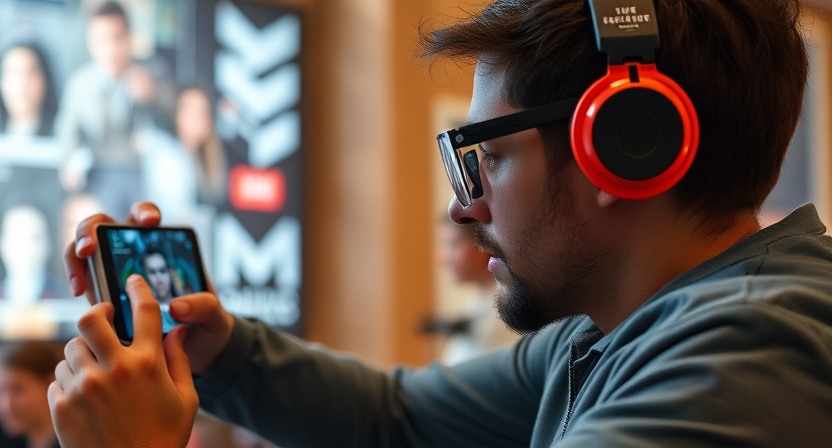
Understanding Augmented Reality and Its Role in Real Estate
Augmented Reality (AR) technology superimposes digital elements—images, sounds, or other data—onto the real world, enhancing how we perceive and interact with our environment. Unlike virtual reality (VR), which immerses users in a completely synthetic world, AR integrates digital features with the physical world in real time. This ability to overlay information in an interactive and realistic manner has quickly become a revolutionary tool in the real estate sector. AR’s potential extends beyond traditional 3D visualization and into creating seamless, interactive experiences that transform property transactions and viewing.
Table of Contents
Why Augmented Reality is Transforming the Property Buying Experience
The property buying experience, historically burdened with time-consuming processes and often overwhelming choices, is being transformed by AR. Buyers can now explore properties from the comfort of their homes, visualize potential renovations, and even interact with properties they are considering in a deeper, more engaging way. Through AR, the property market is evolving, making the process faster, more transparent, and ultimately more satisfying for buyers.
How Augmented Reality Enhances Property Visualization

The Power of Virtual Property Tours
One of the most prominent advantages of AR in real estate is the ability to provide virtual tours of properties. Traditional open houses and viewings have always been constrained by time and location. However, AR allows buyers to take 360-degree virtual tours, giving them the opportunity to explore every corner of a property at their own pace, from anywhere in the world. These immersive tours are equipped with features such as clickable hot spots that provide additional information about rooms, appliances, and amenities.
Seeing Beyond Floor Plans: Visualizing Homes in 3D
For years, buyers have been asked to imagine how a space might look based on floor plans or photographs. With AR, the limitations of static imagery are replaced with interactive 3D models. Buyers can walk through and experience a virtual version of the property, complete with detailed visualizations of the layout, room dimensions, and even natural light conditions throughout the day. This allows for a more tangible understanding of space, leading to more confident decision-making.
Exploring Real-Time Modifications with AR Technology
AR technology enables users to see not only the current state of a property but also its potential. Through live modifications, buyers can alter elements such as wall colors, furniture arrangements, and even structural changes in real-time. This dynamic visualization removes the guesswork from property customization, offering a true preview of what their future home might look like with their personal touch.
The Convenience of Virtual Property Showings
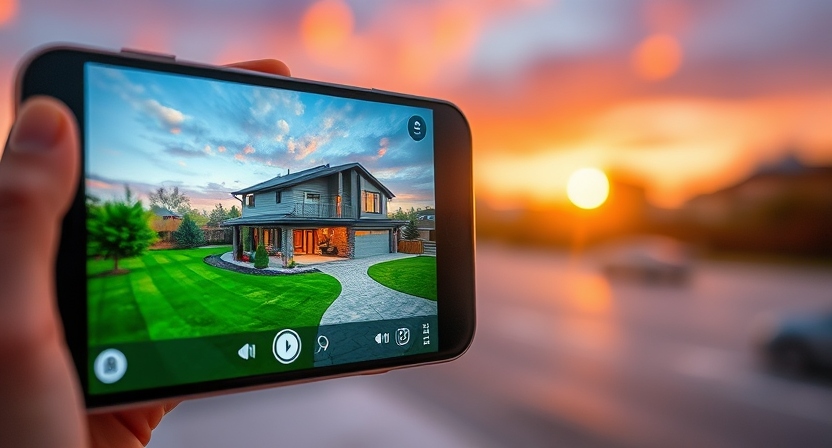
Eliminating the Need for In-Person Visits
With the advent of AR, in-person property visits are no longer a necessity for every buyer. Instead, AR allows for remote viewings, saving valuable time for both buyers and agents. Buyers can virtually walk through properties and make critical decisions without the need for travel or scheduling conflicts. For out-of-town or international buyers, this technology is a game-changer in providing access to properties they otherwise might have never seen.
How AR Can Display Multiple Properties in One Session
AR also solves the problem of property fatigue. Instead of visiting multiple properties in person, buyers can view and compare multiple listings in one virtual session. Real estate agents can create a customized tour that allows buyers to see various homes, side-by-side, with detailed comparisons of each property’s key features. This streamlined process is particularly useful in competitive markets where making swift decisions is crucial
Remote Property Exploration for Long-Distance Buyers
For buyers relocating across states or countries, AR offers the advantage of remotely exploring properties without the need for costly travel. With just an internet connection, potential buyers can engage in live, interactive property tours, narrowing down their options before making the final decision. This level of access eliminates many of the barriers that traditionally come with long-distance property hunting.
Augmented Reality in Home Design and Customization
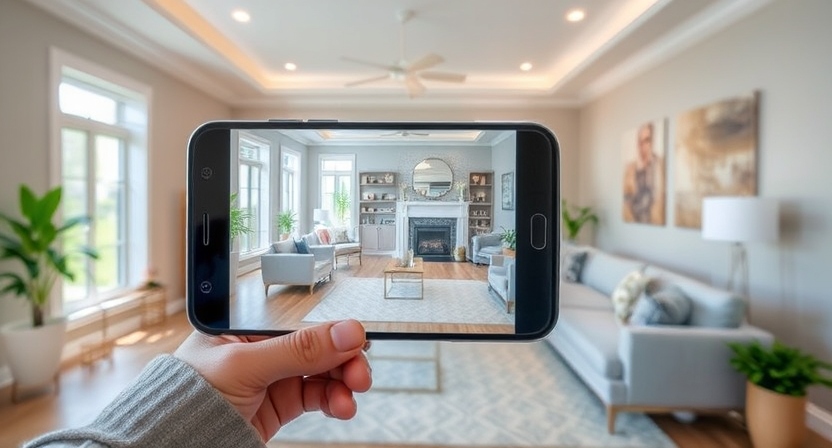
Designing Your Future Home with AR Tools
AR allows prospective buyers to design and customize their future homes digitally. By using AR apps or platforms, buyers can visualize how different styles, furniture, and layouts will look in a space before making any physical alterations. Whether it’s choosing the right paint color or experimenting with floor plans, AR empowers buyers to make informed design decisions.
Visualizing Renovations and Interior Design Options
The ability to envision renovations and modifications before committing to them is another powerful feature of AR in real estate. Whether renovating a kitchen or designing a new living room, AR enables users to simulate changes in real-time. Buyers can see how new designs, materials, or decor will look within their chosen space, creating a more personalized and cost-effective decision-making process.
Creating Virtual Staging to Maximize Property Appeal
Virtual staging is a cost-effective and innovative solution to physical staging. With AR, properties can be virtually furnished and decorated to enhance their appeal. Buyers can view homes with different staging options, helping them to visualize the full potential of a space without the logistical challenges of actual staging.
The Role of AR in Property Selection and Decision-Making
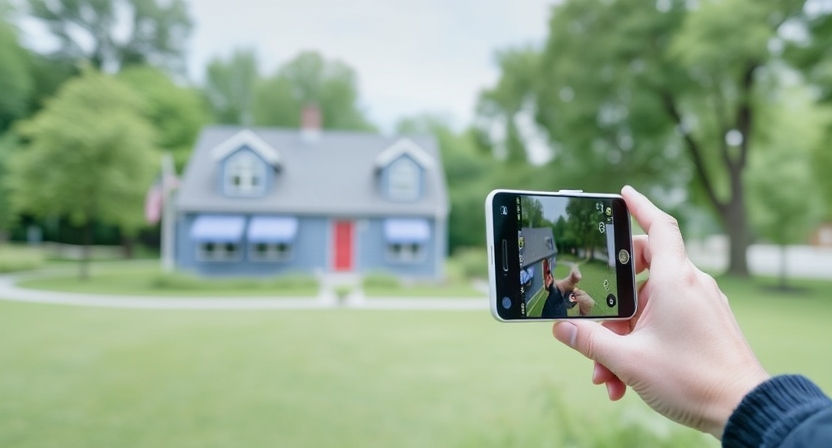
How AR Helps Buyers Make More Informed Choices
When purchasing real estate, information is key. AR helps buyers make better-informed decisions by providing detailed, real-time data about a property’s features, location, and surrounding environment. From assessing room sizes to exploring neighborhood amenities, AR integrates multiple layers of information into a cohesive experience, empowering buyers to consider all variables before making a final commitment.
Simplifying the Selection Process with Real-Time Data
AR can display real-time data that helps buyers narrow down their choices quickly. Whether it’s market trends, property value projections, or neighborhood crime statistics, this information is presented in an easily digestible format, directly within the AR environment. This accessibility accelerates the decision-making process and leads to a higher rate of satisfaction with the final choice.
Leveraging AR to Compare Different Property Features
Comparing properties side-by-side has always been a challenging task. AR technology solves this issue by enabling users to see and interact with various properties in a 3D environment. Features such as square footage, room configurations, and architectural style are displayed clearly, making it easier for buyers to assess which property best meets their needs.
Increasing Buyer Confidence Through AR-Driven Information

Accessing Detailed Property Information Instantly
AR doesn’t just show properties; it enriches the user experience by providing instant access to detailed property information. Buyers can immediately see specifications, availability, and historical data related to each property they interact with. This wealth of information, all available at their fingertips, enhances buyer confidence and reduces hesitation during the decision-making process.
Visualizing Neighborhoods and Local Amenities with AR
Through AR, buyers can step outside the property and explore the surrounding neighborhood in real time. Key amenities, such as schools, parks, shopping centers, and transportation options, can be visually represented in AR, providing buyers with a clearer understanding of the property’s location within its community. This feature enhances the decision-making process by allowing buyers to assess their potential lifestyle in the area before making a commitment.
Using AR to Explore Local Infrastructure and Future Developments
AR technology can also offer a glimpse into the future, showing buyers potential developments and infrastructure projects in the area. For instance, upcoming roads, public transportation routes, or commercial projects can be projected in AR, helping buyers gauge the long-term prospects of a property’s location. This forward-looking perspective adds significant value, especially for those considering future investment.
Improving Communication Between Buyers and Agents
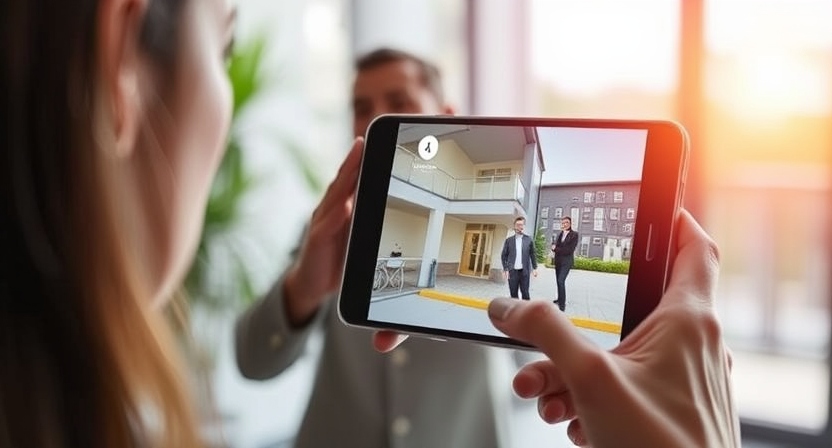
How AR Bridges the Gap Between Buyers and Agents
AR serves as a dynamic tool for real estate agents and buyers to communicate effectively. Rather than simply relying on emails or phone calls, AR enables agents to guide buyers through virtual tours, showcase properties in real-time, and answer questions interactively. This two-way engagement fosters transparency and trust, which are essential in any property transaction.
Instant Collaboration Through Interactive AR Features
Interactive AR features enable buyers to ask questions, request modifications, or view additional details during property tours. For example, a buyer may want to know how a particular feature—such as a pool or garden—would look with certain design elements. AR allows agents to adjust the display on the spot, fostering collaborative decision-making in real time.
Using AR for Detailed Walkthroughs with Real Estate Professionals
For more complex property inquiries or transactions, AR can support detailed walkthroughs, allowing agents to walk buyers through each part of the property virtually. This level of immersion enhances the agent-client relationship by providing a richer, more personalized service that increases engagement and trust.
Augmented Reality and the Future of Property Marketing
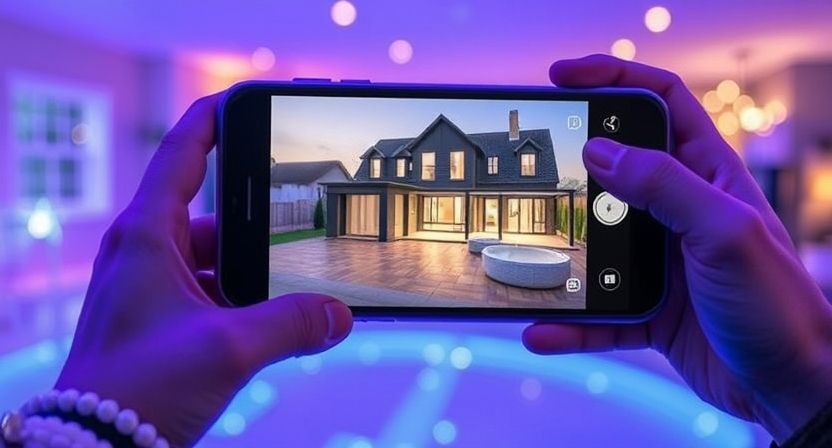
The Rise of AR-Enhanced Listings and Advertisements
AR is reshaping how properties are marketed. Through AR-enhanced listings, potential buyers can interact with images of homes in more meaningful ways. Instead of static photos or videos, listings now offer immersive AR experiences, allowing users to engage directly with property features, such as viewing 3D models or interacting with specific rooms or areas.
How Real Estate Agents are Leveraging AR for Client Engagement
Real estate professionals are increasingly adopting AR technology to captivate potential buyers and differentiate themselves from competitors. By incorporating AR into presentations, virtual tours, and promotional materials, agents create more compelling and memorable experiences that ultimately drive better results in property sales.
The Shift from Traditional Marketing to AR-Powered Campaigns
The integration of AR into marketing campaigns represents a shift from traditional advertising methods. By moving away from static print ads or basic listings, real estate companies are now using AR to offer an interactive, immersive experience that attracts modern, tech-savvy buyers. This transformation enhances visibility, engagement, and conversion rates.
Reducing Decision Fatigue with AR Technology

Making the Property Search Process More Efficient
The property search process can be overwhelming, with countless options and endless details to sift through. AR streamlines this process by offering interactive tools that help buyers quickly visualize, compare, and evaluate properties without the need for excessive back-and-forth with agents or endless site visits.
How AR Narrowing Down Options Improves Buyer Satisfaction
By narrowing down options based on personalized preferences and presenting them in a visually engaging format, AR minimizes the cognitive load on buyers. This efficiency not only saves time but also increases satisfaction, as buyers feel more confident in their ability to choose the right property with less effort.
Eliminating Overwhelm and Uncertainty for First-Time Buyers
First-time buyers often feel overwhelmed by the complexity of the property market. AR eases this burden by presenting information and visuals in an intuitive, user-friendly format. The ability to interact with properties virtually helps first-time buyers make informed decisions with greater confidence and less stress.
The Benefits of AR for Real Estate Investment Buyers
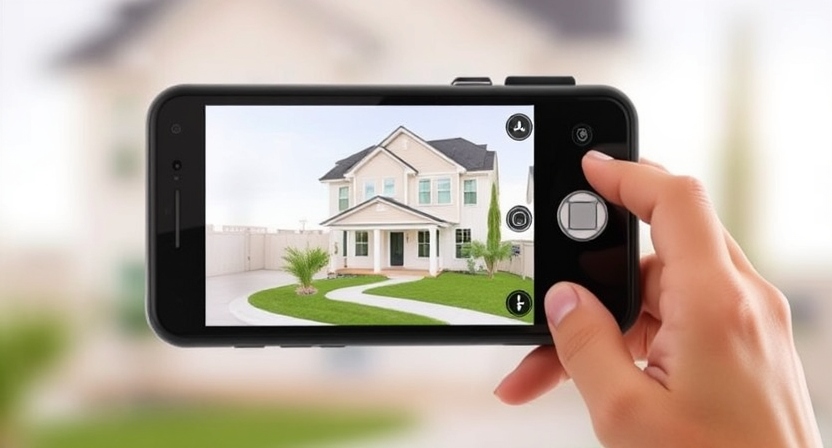
Using AR to Visualize Investment Potential in Properties
For investors, AR provides a powerful tool to visualize the potential of properties. Whether considering renovations, rental prospects, or resale value, AR allows investors to explore different scenarios in a highly interactive manner. This insight helps investors identify high-potential properties and make decisions with greater precision.
How AR Can Help Evaluate Long-Term Value and Growth
AR enhances the ability to predict and evaluate long-term value by integrating data on market trends, neighborhood growth, and future infrastructure developments. Investors can assess how properties might appreciate over time, making AR an indispensable tool for strategic planning and decision-making.
Exploring AR Features for Assessing Rental Properties
In the rental market, AR aids in assessing properties for potential tenants. From visualizing furnishing layouts to showcasing amenities, AR helps investors prepare properties for rent in a way that appeals to a broad audience. This level of customization and presentation enhances the rental process and increases profitability.
Overcoming the Challenges of Implementing AR in Real Estate
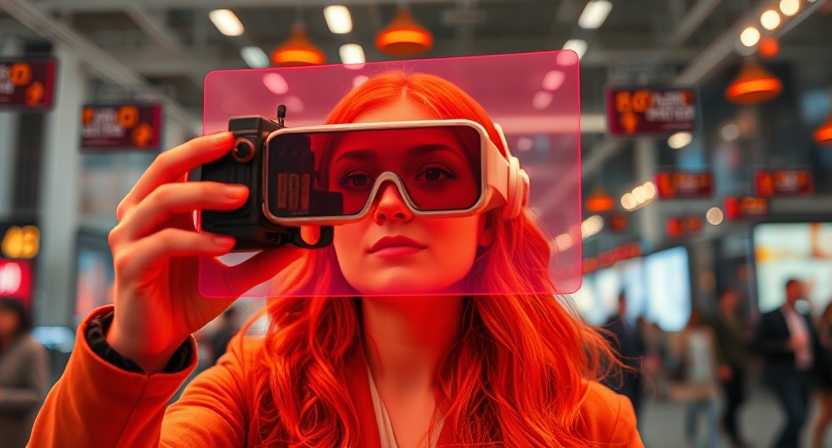
High Costs and Technology Adoption Hurdles
Despite its benefits, the integration of AR in real estate is not without challenges. The initial cost of developing AR systems and applications can be prohibitive for smaller real estate agencies. Custom-built AR tools, sophisticated hardware, and ongoing maintenance require significant financial investment. Moreover, the technology is still in its early stages for widespread adoption, making it difficult for smaller players to compete with industry giants who can afford such advancements.
Addressing the Need for Specialized Equipment
While many AR experiences can be accessed through smartphones and tablets, the full potential of AR often requires specialized equipment like AR glasses or headsets. These devices, although revolutionary, are expensive and not yet ubiquitous among consumers. Convincing buyers and agents to adopt and invest in such equipment remains a hurdle, particularly in markets where technological penetration is still limited.
Overcoming the Learning Curve for Buyers and Agents
Both buyers and real estate agents face a learning curve when using AR tools. Buyers may be unfamiliar with navigating augmented environments, while agents may require training to effectively integrate AR into their marketing and sales strategies. Developing user-friendly applications and providing training resources are critical steps in overcoming this challenge and ensuring widespread usability.
Integrating AR with Other Real Estate Technologies
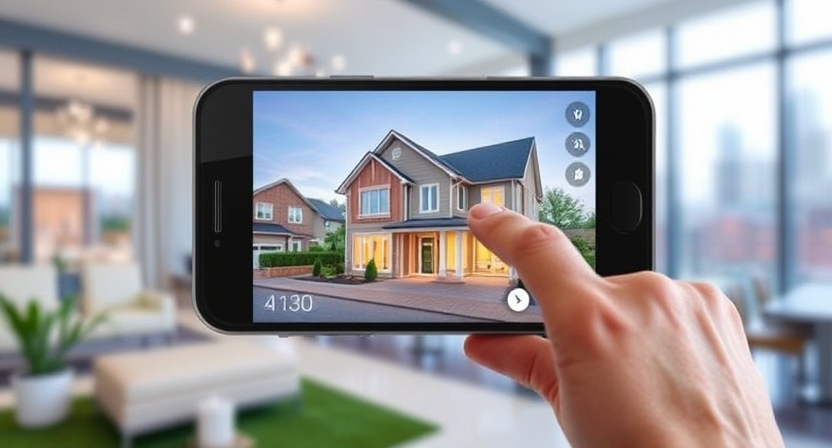
Combining AR with Virtual Reality for Fully Immersive Experiences
While AR enriches the physical environment with digital overlays, combining it with virtual reality (VR) creates fully immersive experiences. This integration allows potential buyers to switch seamlessly between augmented and entirely virtual spaces. For instance, a buyer could explore a property through AR and then use VR to experience an unbuilt or conceptual property in a fully immersive manner, offering the best of both worlds.
Enhancing Property Search Platforms with AR Features
Property search platforms can integrate AR to provide buyers with tools like virtual “try-before-you-buy” experiences. AR-enabled apps can allow users to scan physical locations or explore digital property catalogs with enhanced interactive elements.
How AR Complements AI and Machine Learning in Real Estate
The synergy between AR and artificial intelligence (AI) unlocks unparalleled possibilities in real estate. AI algorithms can analyze buyer preferences, historical data, and market trends to suggest properties tailored to individual needs. When combined with AR, these recommendations can be visually presented in immersive formats, allowing buyers to instantly explore properties that align with their requirements. Additionally, machine learning algorithms can refine AR experiences over time, making them smarter and more intuitive with each interaction.
The Future Outlook of AR in the Real Estate Industry

What’s Next for AR in Property Buying and Selling?
As AR technology continues to evolve, its applications in real estate will expand beyond visualization and decision-making. Future advancements may include predictive tools that analyze environmental data, such as climate resilience or traffic patterns, to provide buyers with deeper insights. Additionally, AR is likely to integrate further into Blockchain-based real estate transactions, enabling secure and transparent property purchases within augmented environments.
How Innovations in AR Will Continue to Shape the Market
Innovations such as advanced AR glasses, holographic displays, and 3D mapping technologies will redefine how properties are marketed and experienced. These tools will make property exploration even more interactive and lifelike, setting new benchmarks for buyer engagement. As AR becomes more sophisticated, it will also enable hyper-personalized experiences, such as adjusting property visuals to match a buyer’s unique aesthetic preferences.
The Potential Impact of 5G on AR Experiences in Real Estate
The advent of 5G technology is poised to revolutionize AR in real estate by addressing latency issues and improving data transfer speeds. With 5G, AR experiences will become smoother and more seamless, supporting high-quality visuals and real-time interactivity. Buyers will be able to access AR applications on the go, making property exploration faster and more accessible than ever.
Conclusion
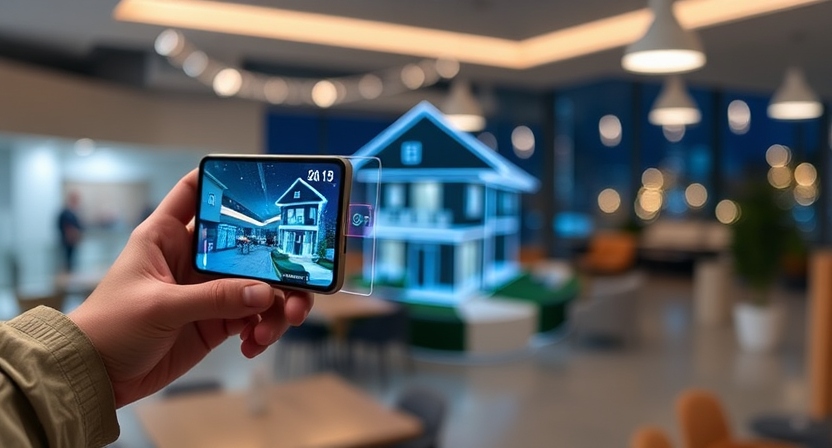
The Long-Term Impact of Augmented Reality on Real Estate Buying
Augmented reality is no longer a futuristic concept; it is rapidly becoming a transformative force in the real estate industry. By bridging the gap between imagination and reality, AR empowers buyers to explore, analyze, and decide on properties with greater precision and confidence.
Why Augmented Reality is Here to Stay in Property Transactions
The growing demand for efficient, engaging, and informative property-buying experiences ensures that AR will remain a cornerstone of the real estate industry. Its ability to simplify complex processes, enhance communication, and increase buyer satisfaction solidifies its place as a long-term asset in property transactions.
Embracing AR for a Smarter, More Efficient Property Buying Journey
Real estate professionals and buyers alike must embrace AR to stay ahead in an increasingly digital world. By leveraging its vast potential, the industry can create smarter, more efficient, and more enjoyable property-buying journeys, setting the stage for a new era of real estate innovation.
Internal Links
Website – Scar Media
Pages to Explore –
Latest Technology
Entrepreneurship
Or you can just follow me on LinkedIn, Facebook and X,
Or Just Subscribe to Articles to receive the latest articles.
External Links
Overview and Benefits of AR in Real Estate: A detailed explanation of AR’s impact on property marketing and buyer engagement, including virtual tours and 3D visualizations. Source: Proven Reality.
Real-Life Applications and Market Trends: Insightful examples of AR in real estate, including virtual furniture placement and neighborhood exploration. Source: Intelivita.
AR Tools for Real Estate: Explore AR applications like MagicPlan and AirMeasure for 3D modeling and accurate measurements. Source: Intelivita.
Case Studies on AR Impact: Information about how AR has revolutionized property visualization and operational efficiency in real estate. Source: G2 Learning Hub.
Future of AR in Real Estate: Discuss predictions for AR’s market growth and integration with real estate technologies. Source: Proven Reality.

